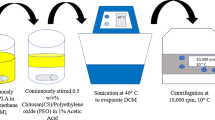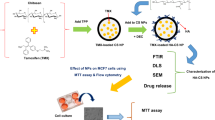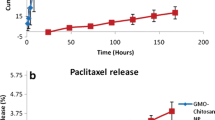Abstract
Purpose
Letrozole (LTZ), an aromatase inhibitor with poor aqueous solubility, is used as the first line treatment for hormonal sensitive breast cancer in postmenopausal women. The purpose of the current study is to develop hyaluronic acid (HA)/chitosan (Cs)-coated poly(d,l-lactide-co-glycolide) (PLGA) nanoparticles for the delivery of LTZ to improve therapeutic efficacy, control release and minimize side effects of LTZ.
Methods
PLGA nanoparticles were prepared, and the effect of various parameters on particle size, surface charge, and encapsulation efficiency was extensively studied. The morphology of nanoparticles was visualized using transmission electron microscopy (TEM), and drug-polymer interactions were studied using differential scanning calorimetry (DSC) and Fourier transform-infrared spectroscopy (FT-IR). The in vitro release kinetics and effect of freeze-drying process on the physicochemical characteristics of nanoparticles were also evaluated. Moreover, the in vivo acute toxicities of blank and drug-loaded nanoparticles were assessed.
Results
PLGA nanoparticles exhibited nanosized (464.3 ± 2.1 nm) spherical particles, negative surface charge (zeta-potential of − 10.5 ± 0.4 mV), and high drug encapsulation efficiency of 63.9 ± 3.7% and sustained drug release pattern over 48 h. The in vivo acute toxicity study revealed that the nanoparticles were well tolerated at a dose of 300 mg/kg.
Conclusion
HA/Cs-coated PLGA nanoparticles might provide a promising system for LTZ delivery and further investigations could confirm their potential efficacy in breast cancer therapy.




Similar content being viewed by others
References
Geisler J, Helle H, Ekse D, Duong NK, Evans DB, Nordbø Y, et al. Letrozole is superior to anastrozole in suppressing breast cancer tissue and plasma estrogen levels. Clin Cancer Res. 2008;14:6330–5.
Laroche F, Coste J, Medkour T, Cottu PH, Pierga JY, Lotz JP, et al. Classification of and risk factors for estrogen deprivation pain syndromes related to aromatase inhibitor treatments in women with breast cancer: a prospective multicenter cohort study. J Pain. 2014;15:293–303.
Goss PE, Strasser K. Aromatase inhibitors in the treatment and prevention of breast cancer. J Clin Oncol. 2001;19:881–94.
Delaney MF. Strategies for the prevention and treatment of osteoporosis during early postmenopause. Am J Obs Gynecol. 2006;194:S12-23.
Bauer M, Bryce J, Hadji P. Aromatase inhibitor-associated bone loss and its management with bisphosphonates in patients with breast cancer. Breast Cancer Targets Ther. 2012;4:91–101.
Vinogradov SV, Bronich TK, Kabanov AV. Nanosized cationic hydrogels for drug delivery: preparation, properties and interactions with cells. Adv Drug Deliv Rev. 2002;54:135–47.
Hughes GA. Nanostructure-mediated drug delivery. Nanomedicine. 2005;1:22–30.
Soppimath KS, Aminabhavi TM, Kulkarni AR, Rudzinski WE. Biodegradable polymeric nanoparticles as drug delivery devices. J Control Release. 2001;70:1–20.
Parveen S, Misra R, Sahoo SK. Nanoparticles: a boon to drug delivery, therapeutics, diagnostics and imaging. Nanomedicine. 2012;8:147–66.
Trif M, Florian PE, Roseanu A, Moisei M, Craciunescu O, Astete CE, et al. A small variation in average particle size of PLGA nanoparticles prepared by nanoprecipitation leads to considerable change in nanoparticles’ characteristics and efficacy of intracellular delivery. J Biomed Mater Res - Part A. 2015;103:3599–611.
Awotwe-Otoo D, Zidan AS, Rahman Z, Habib MJ. Evaluation of anticancer drug-loaded nanoparticle characteristics by nondestructive methodologies. AAPS PharmSciTech. 2012;13:611–22.
Zhang X, Sun M, Zheng A, Cao D, Bi Y, Sun J. Preparation and characterization of insulin-loaded bioadhesive PLGA nanoparticles for oral administration. Eur J Pharm Sci. 2012;45:632–8.
Cun D, Jensen DK, Maltesen MJ, Bunker M, Whiteside P, Scurr D, et al. High loading efficiency and sustained release of siRNA encapsulated in PLGA nanoparticles: quality by design optimization and characterization. Eur J Pharm Biopharm. 2011;77:26–35.
Hariharan S, Bhardwaj V, Bala I, Sitterberg J, Bakowsky U, Ravi Kumar MNV. Design of estradiol loaded PLGA nanoparticulate formulations: a potential oral delivery system for hormone therapy. Pharm Res. 2006;23:184–95.
Bowman K, Leong KW. Chitosan nanoparticles for oral drug and gene delivery. Int J Nanomed. 2006;1:117–28.
Bourguignon LYW, Hongbo Z, Shao L, Chen YW. CD44 interaction with Tiam1 promotes Rac1 signaling and hyaluronic acid- mediated breast tumor cell migration. J Biol Chem. 2000;275:1829–38.
Visvader JE, Lindeman GJ. Cancer stem cells in solid tumours: accumulating evidence and unresolved questions. Nat Rev Cancer. 2008;8:755–68.
Singh PK, Sah P, Meher JG, Joshi S, Pawar VK, Raval K, et al. Macrophage-targeted chitosan anchored PLGA nanoparticles bearing doxorubicin and amphotericin B against visceral leishmaniasis. RSC Adv. 2016;6:71705–18.
Yang L, Gao S, Asghar S, Liu G, Song J, Wang X, et al. Hyaluronic acid/chitosan nanoparticles for delivery of curcuminoid and its in vitro evaluation in glioma cells. Int J Biol Macromol. 2015;72:1391–401.
Fathi HA, Allam A, Elsabahy M, Fetih G, El-Badry M. Nanostructured lipid carriers for improved oral delivery and prolonged antihyperlipidemic effect of simvastatin. Colloids Surf B Biointerfaces. 2018;162:236–45.
Allam A, Fetih G. Sublingual fast dissolving niosomal films for enhanced bioavailability and prolonged effect of metoprolol tartrate. Drug Des Devel Ther. 2016;10:2421–33.
Holzer M, Vogel V, Mäntele W, Schwartz D, Haase W, Langer K. Physico-chemical characterisation of PLGA nanoparticles after freeze-drying and storage. Eur J Pharm Biopharm. 2009;72:428–37.
Chen H, Nan W, Wei X, Wang Y, Lv F, Tang H, et al. Toxicity, pharmacokinetics, and in vivo efficacy of biotinylated chitosan surface-modified PLGA nanoparticles for tumor therapy. Artif Cells Nanomedicine Biotechnol. 2017;45:1115–22.
Budhian A, Siegel SJ, Winey KI. Haloperidol-loaded PLGA nanoparticles: systematic study of particle size and drug content. Int J Pharm. 2007;336:367–75.
Forim MR, dos Santos KC, da Silva MFGF, Pereira-Filho ER, Fernandes JB, Polikarpov I. Polymeric nanoparticles loaded with the 3,5,3´-triiodothyroacetic acid (Triac), a thyroid hormone: factorial design, characterization, and release kinetics. Nanotechnol Sci Appl. 2012;5:37–48.
Musumeci T, Ventura CA, Giannone I, Ruozi B, Montenegro L, Pignatello R, et al. PLA/PLGA nanoparticles for sustained release of docetaxel. Int J Pharm. 2006;325:172–9.
Tefas LR, Tomuţă I, Achim M, Vlase L. Development and optimization of quercetin-loaded plga nanoparticles by experimental design. Clujul Med. 2015;88:214–23.
Madani F, Esnaashari SS, Mujokoro B, Dorkoosh F, Khosravani M, Adabi M. Investigation of effective parameters on size of paclitaxel loaded PLGA nanoparticles. Adv Pharm Bull. 2018;8:77–84.
Jose S, Sowmya S, Cinu TA, Aleykutty NA, Thomas S, Souto EB. Surface modified PLGA nanoparticles for brain targeting of Bacoside-A. Eur J Pharm Sci. 2014;63:29–35.
Feczkó T, Tóth J, Dósa G, Gyenis J. Influence of process conditions on the mean size of PLGA nanoparticles. Chem Eng Process Process Intensif. 2011;50:846–53.
Song X, Zhao Y, Wu W, Bi Y, Cai Z, Chen Q, et al. PLGA nanoparticles simultaneously loaded with vincristine sulfate and verapamil hydrochloride: Systematic study of particle size and drug entrapment efficiency. Int J Pharm. 2008;350:320–9.
Dangi RS, Shakya S. Preparation, optimization and characterization of PLGA nanoparticle. Int J Pharm Life Sci. 2013;4:2810–8.
Xu Y, Asghar S, Yang L, Chen Z, Li H, Shi W, et al. Nanoparticles based on chitosan hydrochloride/hyaluronic acid/PEG containing curcumin: In vitro evaluation and pharmacokinetics in rats. Int J Biol Macromol. 2017;102:1083–91.
Durán-Lobato M, Martín-Banderas L, Gonçalves LMD, Fernández-Arévalo M, Almeida AJ. Comparative study of chitosan- and PEG-coated lipid and PLGA nanoparticles as oral delivery systems for cannabinoids. J Nanoparticle Res. 2015;17:61.
Mahmoodi M, Khosroshahi ME, Atyabi F. Laser thrombolysis and in vitro study of tPA release encapsulated by chitosan coated PLGA nanoparticls for AMI. Int j Biol Biomed Eng. 2010;4:35–42.
Chen H, Yang W, Chen H, Liu L, Gao F, Yang X, et al. Surface modification of Mitoxantrone-loaded PLGA nanospheres with chitosan. Colloids Surf B Biointerfaces. 2009;73:212–8.
de la Fuente M, Seijo B, Alonso MJ. Novel hyaluronan-based nanocarriers for transmucosal delivery of macromolecules. Macromol Biosci. 2008;8:441–50.
Durán V, Yasar H, Becker J, Thiyagarajan D, Loretz B, Kalinke U, et al. Preferential uptake of chitosan-coated PLGA nanoparticles by primary human antigen presenting cells. Nanomed Nanotechnol, Biol Med. 2019;21:102073.
Premasudha P, Venkataramana M, Abirami M, Vanathi P, Krishna K, Rajendran R. Biological synthesis and characterization of silver nanoparticles using Eclipta alba leaf extract and evaluation of its cytotoxic and antimicrobial potential. Bull Mater Sci. 2015;38:965–73.
Mekkawy AI, El-Mokhtar MA, Nafady NA, Yousef N, Hamad M, El-Shanawany SM, et al. In vitro and in vivo evaluation of biologically synthesized silver nanoparticles for topical applications: effect of surface coating and loading into hydrogels. Int J Nanomed. 2017;12:759–77.
Abdelkader A, Fathi HA, Hamad MA, Elsabahy M. Nanomedicine: a new paradigm to overcome drug incompatibilities. J Pharm Pharmacol. 2020;72:1289–305.
Chourasiya V, Bohrey S, Pandey A. Formulation, optimization, characterization and in-vitro drug release kinetics of atenolol loaded PLGA nanoparticles using 33 factorial design for oral delivery. Mater Discov. 2016;5:1–13.
Chakravarthi SS, Robinson DH. Enhanced cellular association of paclitaxel delivered in chitosan-PLGA particles. Int J Pharm. 2011;409:111–20.
Dey SK, Mandal B, Bhowmik M, Ghosh LK. Development and in vitro evaluation of Letrozole loaded biodegradable nanoparticles for breast cancer therapy. Braz J Pharm Sci. 2009;45:585–91.
Portaccio M, Menale C, Diano N, Serri C, Mita DG, Lepore M. Monitoring production process of cisplatin-loaded PLGA nanoparticles by FT-IR microspectroscopy and univariate data analysis. J Appl Polym Sci. 2015;132.
Abdelkader A, El-Mokhtar MA, Abdelkader O, Hamad MA, Elsabahy M, El-Gazayerly ON. Ultrahigh antibacterial efficacy of meropenem-loaded chitosan nanoparticles in a septic animal model. Carbohydr Polym. 2017;174:1041–50.
Taghavi S, Ramezani M, Alibolandi M, Abnous K, Taghdisi SM. Chitosan-modified PLGA nanoparticles tagged with 5TR1 aptamer for in vivo tumor-targeted drug delivery. Cancer Lett. 2017;400:1–8.
Nath SD, Abueva C, Kim B, Lee BT. Chitosan-hyaluronic acid polyelectrolyte complex scaffold crosslinked with genipin for immobilization and controlled release of BMP-2. Carbohydr Polym. 2015;115:160–9.
Gomathi T, Sudha PN, Florence JAK, Venkatesan J, Anil S. Fabrication of letrozole formulation using chitosan nanoparticles through ionic gelation method. Int J Biol Macromol. 2017;104:1820–32.
Alemrayat B, Elhissi A, Younes HM. Preparation and characterization of letrozole-loaded poly(d, l-lactide) nanoparticles for drug delivery in breast cancer therapy. Pharm Dev Technol. 2019;24:235–42.
Mainardes RM, Gremião MPD, Evangelista RC. Thermoanalytical study of praziquantel-loaded PLGA nanoparticles. Rev Bras Cienc Farm. 2006;42:523–30.
Nashaat D, Elsabahy M, El-Sherif T, Hamad MA, El-Gindy GA, Ibrahim EH. Development and in vivo evaluation of chitosan nanoparticles for the oral delivery of albumin. Pharm Dev Technol. 2019;24:329–37.
Han L, Zhao Y, Yin L, Li R, Liang Y, Huang H, et al. Insulin-loaded pH-sensitive hyaluronic acid nanoparticles enhance transcellular delivery. AAPS PharmSciTech. 2012;13:836–45.
Guo M, Rong WT, Hou J, Wang DF, Lu Y, Wang Y, et al. Mechanisms of chitosan-coated poly(lactic-co-glycolic acid) nanoparticles for improving oral absorption of 7-ethyl-10-hydroxycamptothecin. J Nanotechnol. 2013;24:245101.
Khvedelidze M, Mdzinarashvili T, Partskhaladze T, Nafee N, Schaefer UF, Lehr CM, et al. Calorimetric and spectrophotometric investigation of PLGA nanoparticles and their complex with DNA. J Therm Anal Calorim. 2010;99:337–48.
Ramalho MJ, Loureiro JA, Gomes B, Frasco MF, Coelho MAN, Carmo PM. PLGA nanoparticles as a platform for vitamin D-based cancer therapy. Beilstein J Nanotechnol. 2015;6:1306–18.
Chinedu E, Arome D, Ameh FS. A new method for determining acute toxicity in animal models. Toxicol Int. 2013;20:224–6.
Walum E. Acute oral toxicity. Env Heal Perspect. 1998;106:497–503.
Jana U, Mohanty AK, Pal SL, Manna PK, Mohanta GP. Felodipine loaded PLGA nanoparticles: preparation, physicochemical characterization and in vivo toxicity study. Nano Converg. 2014;1.
Ferrero S, Gillott DJ, Venturini PL, Remorgida V. Use of aromatase inhibitors to treat endometriosis-related pain symptoms: a systematic review. Reprod Biol Endocrinol. 2011;9:83.
Kumar Jana S. Letrozole and curcumin loaded-PLGA nanoparticles: a therapeutic strategy for endometriosis. J Nanomedine Biother Discov. 2014;04.
Funding
The authors received financial support from the Academy of scientific Research and Technology (Grant reference no: ASRT/SNG/H/2014-6, Scientists for Next Generation (SNG)).
Author information
Authors and Affiliations
Corresponding author
Ethics declarations
Conflict of Interest
The authors declare that they have no conflict of interest.
Additional information
Publisher’s Note
Springer Nature remains neutral with regard to jurisdictional claims in published maps and institutional affiliations.
Supplementary Information
Below is the link to the electronic supplementary material.
Rights and permissions
About this article
Cite this article
Radwan, R., Abdelkader, A., Fathi, H.A. et al. Development and Evaluation of Letrozole-Loaded Hyaluronic Acid/Chitosan-Coated Poly(d,l-lactide-co-glycolide) Nanoparticles. J Pharm Innov 17, 572–583 (2022). https://doi.org/10.1007/s12247-021-09538-5
Accepted:
Published:
Issue Date:
DOI: https://doi.org/10.1007/s12247-021-09538-5




